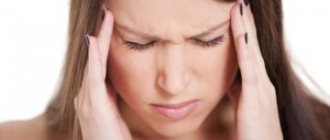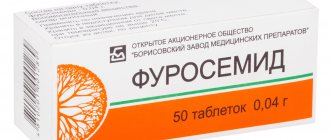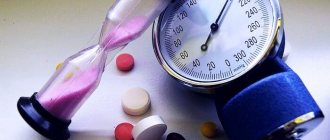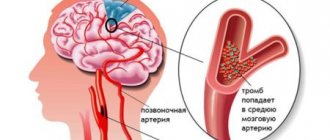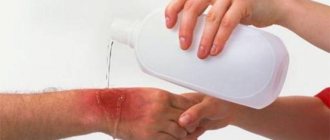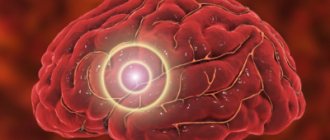Complications after a hypertensive crisis
What is a hypertensive crisis? It is a state of sharp and sudden increase in blood pressure. Complications of a hypertensive crisis affect target organs: heart, brain, eyes and kidneys. If proper assistance is not provided or in advanced cases, irreversible pathologies begin to develop, leading to the loss of organ functions.
Cerebrovascular accident
Symptoms of the disorder are confusion (up to coma), vomiting, ataxia, dysarthria, paresis of facial muscles, facial asymmetry. Patients have severe headaches, hemiparesis and aphasia. If symptoms appear, the patient is urgently hospitalized. In the hospital, an ECG is required, breathing is normalized using an air duct, and medications are given to lower blood pressure. Acute cerebrovascular accident develops most often during a complicated hypertensive crisis.
Stroke has two forms: ischemic and hemorrhagic.
Hypertensive encephalopathy
Poor circulation leads to focal damage to the brain substance. Hypertensive crisis complicated by encephalopathy has three stages. The first is accompanied by headache, confusion, nausea, weakness, memory loss and sleep disturbances. The second stage has symptoms of a vestibular, pyramidal, ataxic and cephalgic nature. The third stage is the most difficult - convulsions, drop attacks, seizures, speech impairment, and coma occur. Treatment is aimed at restoring blood flow, improving cerebral metabolism and normalizing blood pressure.
Heart failure
Sometimes acute deficiency causes hypertension. This is explained by a decrease in blood supply to the kidneys and the accumulation of water and sodium in the body. As a result of decreased blood output from the heart, peripheral vasoconstriction occurs. This factor leads to a rapid increase in pressure.
In case of a hypertensive crisis with left ventricular failure, it is urgent to lower blood pressure. Drugs are prescribed to reduce the load on the heart. These include loop diuretics and oxygen, nitroglycerin, sodium nitroprusside with morphine.
Angina and heart attack
Hypertension leads to an increase in the load on the heart, which entails changes in the walls of the left ventricle. They experience great stress, and there is a need for more oxygen. As a result, failure develops, which usually ends in myocardial infarction. Unstable angina can also trigger symptoms of a heart attack or its development.
An attack of ischemia that accompanies the disease increases blood pressure to critical levels.
First aid during a crisis is the administration of intravenous nitroglycerin or antianginal medications. Beta blockers and ACE inhibitors can also be used. Lowering blood pressure is not the main goal of providing assistance - attention should be focused on restoring normal blood flow. To do this, they resort to thrombolysis, genarinotherapy, angioplasty or coronary artery bypass grafting.
Aortic aneurysm
One of the most complex pathologies after a crisis is dissecting aortic aneurysm. Strong blood pressure in the vessels ruptures the largest artery of the body from the inside. Blood enters the interlayer space in the walls of the aorta, causing gradual dissection. If three walls are damaged, severe bleeding begins. Without prompt medical care in the first 24 hours, death occurs in 25% of patients. After a week, the mortality rate increases to 50%, and during the first year after the attack it is more than 90%.
Most often, this consequence of a hypertensive crisis in women manifests itself during pregnancy with a diagnosis of coarctation of the aorta and bicuspid aortic valve.
An aneurysm is accompanied by severe pain in the chest, neck, and throat. Less commonly, the pain spreads to the teeth, abdominal cavity and lower back.
After the pressure decreases, the affected area is identified using angiography. If the diagnosis confirms the third type of dissection, then a course of medications is prescribed. Dissection of the first and second types cannot be done without surgical intervention.
Cardiac asthma
The first signs are a feeling of lack of air, shortness of breath, dry cough, increased blood pressure, agitation, and an unreasonable, unreasonable feeling of fear. Accompanied by a sharp decrease in myocardial contractility, as well as stagnation of blood in the pulmonary circulation. This causes breathing problems and can lead to pulmonary edema. Requires immediate first aid and hospitalization, otherwise there is a high probability of death. The patient needs rest, a hot foot bath and a semi-sitting position. A tablet of nitroglycerin or nifedipine is given every 10 minutes with a mandatory check of blood pressure readings.
If shortness of breath develops into suffocation, narcotic analgesics are needed.
Arrhythmia
There are several types of cardiac arrhythmia:
- Type 1: associated with a violation of the frequency of contractions of the heart muscle,
- Type 2: associated with the appearance of irregular rhythms,
- Type 3: associated with a disturbance in the conduction of electrical impulses in the myocardium.
It manifests itself in the form of severe headaches and dizziness, a significant drop in blood pressure, pain in the heart, loss of consciousness and fainting. Treatment consists of a mandatory potassium diet and the use of drugs such as lidocaine, ethmosin, metoprolol, amiodarone and diltiazem.
Retinal detachment
Symptoms: photopsia, rapid deterioration of vision. May be accompanied by headache. Requires immediate treatment, as it often leads to complete loss of vision. With the help of surgical intervention, the layers of the retina are forced together. This can occur both on the surface of the sclera and inside the eyeball.
Migraine
Vascular crisis is a pathological condition associated with a sharp change in the normal filling of blood vessels. Develops against the background of circulatory disorders.
The most common type of crisis is migraine. The first phase of the attack is almost imperceptible: at this time, spasms of cerebral vessels occur. The second phase is characterized by rapid dilation of blood vessels, which leads to severe throbbing pain. The third phase manifests itself in the form of a dull, pressing pain. Requires analgesics, ergots or triptans.
Complicated hypertensive crises require hospitalization.
Doctors prescribe medications that lower blood pressure. Most often, medications are administered intravenously. To alleviate the patient's condition, oxygen therapy, diuretics, antiemetics and sedatives, diuretics and painkillers are prescribed.
To treat the diseases that provoked the crisis, neurologists, cardiologists, nephrologists and endocrinologists are involved. Hypertensive crisis can be cured if help is provided in a timely manner.
What to do
First aid for a hypertensive crisis is to quickly relieve symptoms and lower blood pressure.
Emergency care begins with creating favorable conditions for the patient. It is important to reassure the person and be there. Be sure to ventilate the room, as the patient needs fresh air.
An uncomplicated condition (pressure up to 160 mmHg) for a person not taking medication for hypertension can be corrected using conservative methods. This includes massage, proper breathing, rubbing the heels with vinegar, applying mustard plasters to the calf muscles, and a hot bath for the feet. You can give a crushed clonidine tablet under the tongue.
Even in cases where the pressure was able to be normalized on its own, seeking advice from a therapist is mandatory!
If the patient took pills for hypertension, then it is necessary to ensure that he uses the drugs prescribed by the doctor.
Recommended drugs for hypertensive crisis and treatment of emergency conditions
| Drugs | Recommended dose |
| Clonidine | First dose 0.2 mg; if necessary, repeat after an hour |
| Labetalol | 200 mg orally; repeat after 2 hours |
| Captopril | 25 mg; repeat after 4 hours |
| Prazosin | 2 mg; if necessary, repeat after an hour |
If taking medications does not reduce blood pressure within the first hours, you must call an ambulance. The doctor will give an intravenous injection.
Most often, in critical situations, the patient needs hospitalization and full medical supervision. The person is placed in the intensive care unit. The task of specialists is to smoothly reduce the pressure. A sharp decrease in blood pressure can disrupt the functioning of the heart and kidneys.
In critical cases, blood pressure is reduced to 160 per 100 mm Hg. Then the body’s reaction is observed, followed by a slow decrease in blood pressure.
In case of anxiety states of hypertensive crises, special parenteral drugs are used: Nitroprusside, Nitroglycerin, Labetalol, Hydralazine, Enalaprilat.
Recovery after the crisis
Restoring health after a crisis is possible only with the help of a doctor who selects an individual rehabilitation program. What it includes depends on the type of hypertensive crisis, complications and their degree, characteristics of the patient and concomitant diseases. Recovery after a hypertensive crisis is complex and includes:
- special diet
- Therapeutic exercise,
- Use of medications
- Maintaining a healthy lifestyle.
If rehabilitation after a hypertensive crisis takes place at home, it is necessary to exclude any vigorous activity. The patient needs to lie down more, monitor his emotional state, and refuse any housework.
Features of the disease and consequences
Hypertensive crisis is a dangerous pathological condition provoked by a sudden increase in blood pressure (BP). It requires urgent measures to normalize it.
The cause of the attack is most often chronic hypertension, and the provocateurs are:
- stress or psycho-emotional tension;
- stopping taking antihypertensive drugs;
- great physical activity;
- alcohol consumption;
- change of weather.
A sign of the onset of a crisis is a rapid increase in blood pressure. In this situation, systolic blood pressure rises above 140 mmHg.
Associated symptoms are pain in the occipital region of the head, dizziness, tremors, problems with vision and coordination of movements, nausea, hyperemia, convulsions, shortness of breath. The pathological condition lasts from several hours to several days. During a crisis, the blood flow to the brain, lungs, heart, and other organs is disrupted, and the central nervous system is damaged.
In the absence of immediate qualified assistance, there is a high probability of complications, the most dangerous of which are:
- stroke or acute heart attack;
- swelling of the brain or lungs;
- angina or retinopathy;
- renal failure.
Since a sudden jump in blood pressure does not go away without leaving a trace, a rehabilitation period is mandatory.
After the pressure returns to normal, the patient is discharged to home, where subsequent treatment is carried out at home.
Physical exercise
The most effective and efficient remedy for recovery after a crisis is gymnastics or physical education. Physical activity should be feasible, regular and daily. You need to start with 15-20 minutes a day, gradually increasing the complexity and duration of classes. Exercise will not only have a positive effect on the myocardium and blood pressure, but will also help you lose extra pounds, build muscle definition and improve overall well-being. During training, it is necessary to monitor your pulse and breathing, and avoid overwork or severe physical fatigue. You can do physical therapy, yoga, cardio exercises, and breathing exercises. Swimming and aqua gymnastics, hippotherapy, and walks in the fresh air have a good effect.
Sanatorium-resort restoration
After a hypertensive crisis, many patients are prescribed spa treatment and recovery. Individual nutrition is selected for the patient based on the doctor’s testimony and the characteristics of the course of the disease. The menu includes only natural and healthy products. Additional drug therapy and physiotherapy, sunbathing, wave therapy and gymnastics, and massage are often prescribed. The type of crisis and its consequences determine the type of sanatorium treatment: some boarding houses specialize in recovery after a stroke, heart attack, or heart failure. But there is also a general, comprehensive plan.
How to live after a crisis
After a hypertensive crisis, it is necessary to lead a constant healthy lifestyle, take medications and eat right. It is wrong to believe that it is enough to achieve noticeable improvements to cancel the diet or return to the usual active rhythm of life. There is always a chance of developing a stroke, arrhythmia, pulmonary edema and other consequences. Basic rules for those who are in the process of recovery after HA:
- Refusal of any increased emotional or physical stress,
- Elimination of any sources of stress,
- Rejection of bad habits,
- Normalization of sleep. You need to sleep at least 10 hours a day, also setting aside time for daytime sleep,
- Daily walks
- If you are diagnosed with hypertension, keep a diary where you record daily blood pressure readings,
- Take medications prescribed by your doctor regularly
- To restore the nervous system, take sedative medications and herbal teas.
Pathology therapy
Dizziness and severe weakness after a hypertensive crisis suggest a long course of antihypertensive therapy, since painful symptoms occur against the background of high blood pressure.
A comprehensive rehabilitation program includes the following:
- Regular measurement of blood pressure;
- The use of several types of antihypertensive medications.
The optimal dosage of medications is selected by a specialist individually, based on the present symptoms, the patient’s body’s response to the proposed treatment, the degree of damage to internal organs and systems during a hypertensive crisis, and other features of a particular clinical case.
If dizziness does not go away after the treatment course described above, then its cause is low blood pressure after a hypertensive crisis, caused by prolonged use of a large number of antihypertensive medications. In this case, positive results can be achieved by simply reducing the daily dosage of medications or dividing the total dose into several doses.
However, if the condition does not improve even after this, you should seek professional advice from a qualified specialist as soon as possible! Low blood pressure in patients suffering from hypertension, especially after a hypertensive crisis, may indicate the development of a number of dangerous pathologies (brain diseases, diabetes mellitus, spinal cord damage)!
After a hypertensive crisis, patients suffering from dizziness, asthenia, and migraine attacks are advised to monitor blood pressure around the clock in order to objectively assess the patient’s condition and identify the causes of pathological symptoms.
Regular blood pressure monitoring should become a good habit for a person who has had a hypertensive attack.
Antihypertensive drugs
Dizziness after a hypertensive crisis can be controlled with drug therapy. In most cases, patients are prescribed the following antihypertensive drugs during the recovery period:
- Beta blockers - help reduce the load on the heart muscle, stabilize blood pressure, normalize heart rate and effectively combat rapid heart rate;
- ACE inhibitors - stabilize blood pressure, having a positive effect on renal tissue structures and heart muscle;
- Combined antihypertensive drugs are new generation drugs that combine the beneficial properties of other antihypertensive medications. The advantage of this group of drugs is the prolonged therapeutic effect, as well as the absence of the need for frequent use of tablets.
To relieve dizziness after a hypertensive crisis, in addition to stabilizing blood pressure, it is also necessary to improve functional circulation. For this, patients are prescribed diuretics that eliminate swelling, congestive phenomena, and reduce the degree of load on the cardiovascular system:
- Distal diuretics are mild agents used for mild painful symptoms.
- Loop diuretics have a pronounced therapeutic effect, but entail a number of side effects, such as dehydration, leaching of potassium and sodium.
All medications after a hypertensive crisis are prescribed by the doctor individually. The dosage regimen, dosage and duration of treatment are also determined by a specialist. A sharp decrease in blood pressure during a hypertensive crisis and after an attack, in addition to dizziness, can provoke more dangerous complications, such as stroke or impaired brain function.
All blood pressure medications can only be taken as prescribed by a doctor.
Home techniques
To relieve attacks of dizziness after a hypertensive crisis at home, you should pay attention to the following recommendations from specialists:
- Gradual increase in physical activity, physical therapy exercises;
- Controlling body weight and reducing the weight category by 5% if you have extra pounds;
- Maintaining a daily routine;
- Rejection of bad habits;
- Healthy, properly balanced diet;
- Elimination of stress factors that cause nervous disorders and psycho-emotional shocks;
- Regular use of medications prescribed by your doctor in the recommended dosage;
- Constant monitoring of blood pressure, pulse, heart rate;
- Monitor for symptoms of high blood pressure (dizziness, shortness of breath, panic attacks, tachycardia, headaches, arrhythmia), and promptly seek professional medical help.
Special attention should be paid to the patient's diet. People who have suffered a hypertensive crisis must refrain from drinking alcohol, salt and salty foods, animal fats, and smoking.
Fear of a new crisis developing
Often after the first GC, patients develop fears of a recurrence of the attack. Patients begin to worry, look for symptoms of an approaching crisis, and succumb to panic. The condition is aggravated by the growing fear of death. Against the background of constant anxiety, insomnia develops. All this leads to a general deterioration in health: pain in the heart, shortness of breath, nervousness.
The patient finds himself in a vicious circle: fear causes internal stress, which increases blood pressure. The result is even more fear. This condition requires mandatory treatment. If phobias appear after a hypertensive crisis, the patient is prescribed a course of psychotherapy and special medications.
Associated symptoms
The condition after a hypertensive crisis, in addition to dizziness, is manifested by painful clinical signs of the brain, renal apparatus, and cardiovascular system.
Weakness and dizziness after a hypertensive crisis are consequences of damage to the central nervous system. In addition, patients often complain of headaches and confusion. It is even possible to fall into a coma.
Medical experts identify the following most common symptoms after a hypertensive crisis that accompany dizziness:
- Nausea;
- Attacks of vomiting;
- Chronic fatigue;
- Muscular hypertonicity;
- Paleness of the skin;
- Severe weakness;
- Spatial disorientation;
- Excessive sweating.
Headache after a hypertensive crisis in combination with dizziness, lethargy, and apathy are signs of autonomic disorders caused by disorders in the vestibular apparatus.
Hypertensive patients often complain of a feeling of fear, panic attacks, accompanied by severe dizziness.
However, according to medical experts, when you feel dizzy and have a headache after a hypertensive crisis, this is a completely normal phenomenon that does not pose a potential threat to the health, much less the life of the patient.
However, weakness and other painful symptoms of a vegetative nature reduce ability to work and negatively affect a person’s quality of life. For this reason, special treatment is carried out to promote accelerated recovery after a crisis, eliminate dizziness, pain and other consequences of exacerbation of arterial hypertension.
Headaches, weakness, and fatigue accompany a person after a hypertensive crisis.
Nutrition after a crisis
After a hypertensive crisis, patients should adhere to a diet and follow the following recommendations:
- Drink no more than 1.5 water per day,
- Reduce daily calories
- Consume no more than 3-4 g of salt per day,
- Go to six meals a day, and each serving should be no more than 350 g.
The following should be completely excluded from a hypertensive diet:
- Sugar and sweets
- Pickles, marinades,
- Hot spices,
- Smoked meats,
- Cocoa, coffee, carbonated drinks, energy drinks,
- Fatty meats, poultry, fish,
- Meat products (wieners, sausages),
- Semi-finished products
- Fast food.
For hypertensive patients after a crisis, various cereals, vegetable broths, fresh vegetables and fruits are useful. Be sure to include lean fish, rabbit meat, and seafood in your diet. If possible, you need to eat as many cranberries, blueberries, and lingonberries as possible. The diet during a hypertensive crisis can be salt-free or low-carbon - in agreement with the attending physician.
Video on the topic
The most common complications of hypertension:
Rehabilitation is the most important stage of the post-crisis state. The doctor’s program is drawn up on an individual basis. Knowing how to behave after a crisis and following all the necessary recommendations, you can safely avoid the consequences of a dangerous illness.
The information on the MyMedNews.ru website is for reference and general information, collected from publicly available sources and cannot serve as a basis for making a decision on the use of medications in the course of treatment.
MyMedNews.ru
And we also have
Normal systolic and diastolic pressure in men by age
